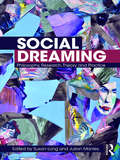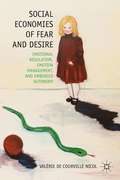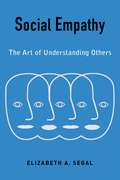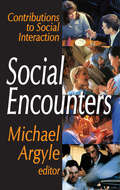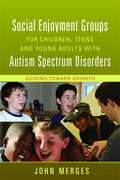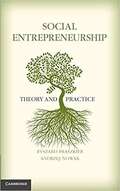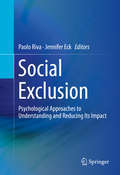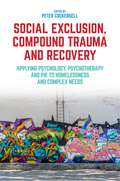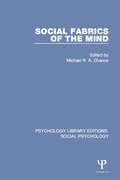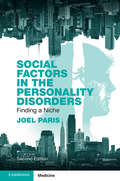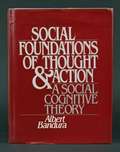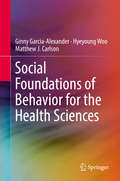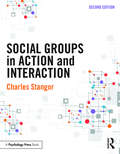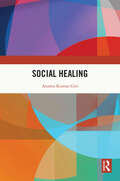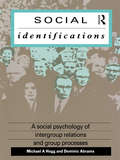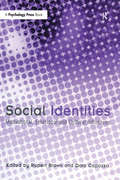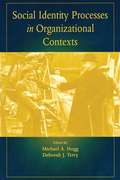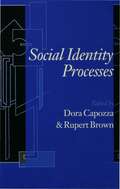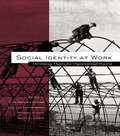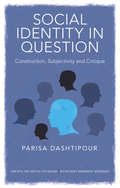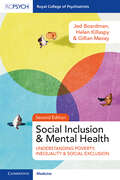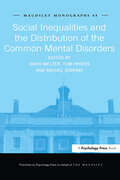- Table View
- List View
Social Dreaming: Philosophy, Research, Theory and Practice (Studies in the Psychosocial)
by Susan Long Julian ManleyThe idea of social dreaming argues that dreams are relevant to the wider social sphere and have a collective resonance that goes beyond the personal narrative. In this fascinating collection, the principles of social dreaming are explored to uncover shared anxieties and prejudices, suggest likely responses, enhance cultural surveys, inform managerial policies and embody community affiliation. Including, for the first time, a coherent epistemology to support the theoretical principles of the field, the book reflects upon and extends the theory and philosophy behind the method, as well as discussing new research in the area, and how social dreaming practice is conducted in a range of localities, situations and circumstances. The book will appeal to anyone interested in the idea that social dreaming can help us to delve deeper into the question of what it means to be human, from psychoanalysts to sociologists and beyond.
Social Ecology of a Chinese Kindergarten: Where culture grows (Cultural Psychology of Education #12)
by Giuseppina Marsico Shuangshuang XuThis book is the outcome of a joint collaboration between East China Normal University and the University of Luxembourg, initiated by the Center of Ideas for the Basic Education of the Future (IBEF), and focuses on kindergartens in China from a cultural psychology perspective. By coupling young scholars from diverse cultural backgrounds as research tandems, this book uses an innovative methodological method to reveal a deeply immersing research perspective of the often complicated issues in the Chinese social reality, where long historical tradition and strong motivation for a “modernized” future are fused together and continuously evolve itself into a vibrant and intricate landscape. Meanings and values consciously or unconsciously promoted and conducted in the kindergarten are semiotic devices and they mediate children’s and educator’s daily behaviours and activities, which are constantly navigating among different social institutions and crossing the border of kindergarten. The book discusses the process of children’s socialization in the kindergarten from different angles such as cultural objects, moral education, conflict negotiation, children's drawing analysis and the role of Lego in numeracy development. It also provides an overview of basic educational needs in Chinese kindergartens as well as three commentaries to provide background information and to add a reflective angle for the readers. By reading the book, readers will hopefully go through a constantly transforming process between familiarizing and de-familiarizing along with the research tandem and develop their own understanding of the complex landscape of the Chinese kindergarten and its children as developing subjects constantly living and transcending the context.
Social Economies of Fear and Desire: Emotional Regulation, Emotion Management, and Embodied Autonomy
by Valérie de Courville NicolAll behaviours, indeed all forms of agency, are viewed as emotionally-driven. This book provides an approach to emotional experience and agency which drastically nuances the commonly held view that fear has predominantly irrational, morally, or ideologically suspect effects which thwart the exercise of autonomy.
Social Empathy: The Art of Understanding Others
by Elizabeth SegalOur ability to understand others and help others understand us is essential to our individual and collective well-being. Yet there are many barriers that keep us from walking in the shoes of others: fear, skepticism, and power structures that separate us from those outside our narrow groups. To progress in a multicultural world and ensure our common good, we need to overcome these obstacles. Our best hope can be found in the skill of empathy.In Social Empathy, Elizabeth A. Segal explains how we can develop our ability to understand one another and have compassion toward different social groups. When we are socially empathic, we not only imagine what it is like to be another person, but we consider their social, economic, and political circumstances and what shaped them. Segal explains the evolutionary and learned components of interpersonal and social empathy, including neurobiological factors and the role of social structures. Ultimately, empathy is not only a part of interpersonal relations: it is fundamental to interactions between different social groups and can be a way to bridge diverse people and communities. A clear and useful explanation of an often misunderstood concept, Social Empathy brings together sociology, psychology, social work, and cognitive neuroscience to illustrate how to become better advocates for justice.
Social Encounters: Contributions to Social Interaction
by Michael ArgyleSocial Encounters is an approach to social psychology that is not what one might expect to find in textbooks on this subject. As a companion to Social Interaction advocated by Michael Argyle and his associates, it has been used by a rapidly growing number of researchers in social psychology, and related aspects of ethology, anthropology, and linguistics. The two key ideas are to study the detailed processes of social interaction at the level of the elements of interaction, and to relate social behavior to its biological basis and cultural setting.This work collects excellent representative studies of different aspects of social interaction; as such they are important in their own right. Within the general approach described, a range of different academic orientations are included. All selections report empirical findings, and most of them introduce conceptual notions as well. One achievement of the volume has been to establish the basic elements of which social interaction consists; current research is concerned with finding out precisely how these elements function.The contributors agree that the field consists of various signals: verbal and non-verbal, tactile, visible and audible, bodily contact, proximity, orientation, bodily posture, physical appearance, facial expression, movements of head and hands, direction of gaze, timing of speech, emotional tone of speech, speech errors, type of utterance and linguistic structure of utterance. These elements can be further analyzed and divided into categories or dimensions; each plays a distinctive role in social interaction. Social behavior is studied in natural settings or replicas of natural settings, for which there are cultural rules familiar to the subjects. This is a pioneering statement in sociobiology.
Social Enjoyment Groups for Children, Teens and Young Adults with Autism Spectrum Disorders
by John MergesYoung people with autism spectrum disorders (ASD) often feel uncomfortable and anxious in social situations, but socializing with classmates and colleagues can be made easier - and more enjoyable - with Guiding Toward Growth group sessions. John Merges' simple yet effective program for teaching social enjoyment skills is based on the concept that there are ten hurdles that make it challenging for people with ASD to enjoy social interaction. This book guides the reader through planning, running, and assessing group sessions that have been designed to help participants overcome these hurdles, interact with confidence, and ultimately enjoy more independent and fulfilling lives. As social interaction is a vital element of any work environment, this book also teaches young adults with ASD an important employment skill. This adaptable book can be used with a wide range of ages and communicative abilities, and will be an invaluable resource for all professionals working with groups of children and young people with ASD.
Social Entrepreneurship: Theory and Practice
by Ryszard Praszkier Andrzej NowakSocial Entrepreneurship: Theory and Practice is about the creative ways in which social entrepreneurs solve pressing and insurmountable social problems. Theories of social change are presented to help demystify the 'magic' of making an immense, yet durable and irreversible, social impact. Utilizing case studies drawn from various fields and all over the world, the authors document how social entrepreneurs foster bottom-up change that empowers people and societies. They also review the specific personality traits of social entrepreneurs and introduce the new kind of leadership they represent. This book will be valuable to undergraduate, graduate and postgraduate students, while remaining accessible to non-academic readers thanks to its clear language, illustrative case studies and guidelines on how to become a successful social entrepreneur.
Social Exchanges: Interpersonal Skills For College And Beyond
by Tasha F. DavisSocial Exchanges: Interpersonal Skills For College And Beyond by Tasha F. Davis
Social Exclusion
by Paolo Riva Jennifer EckFrom ostracism on the playground to romantic rejection, bullying at work, and social disregard for the aged, individuals are at constant risk of experiencing instances of social exclusion, including ostracism, rejection, dehumanization, and discrimination. These phenomena have a powerful impact as testified by their immediate influence on people's thoughts, emotions, and behaviors. Social Exclusion: Psychological Approaches to Understanding and Reducing Its Impact investigates different psychological approaches, across multiple psychological subdisciplines, to understanding the causes and consequences of social exclusion and possible ways to reduce or buffer against its negative effects. The purpose of this volume is threefold. First, it lays the groundwork for the understanding of social exclusion research; reviewing the different instances of social exclusion in everyday life and methods to experimentally investigate them. Second, this volume brings together different psychological approaches to the topic of social exclusion. Leading scholars from around the world contribute perspectives from social psychology, social neuroscience, developmental psychology, educational psychology, work and organizational psychology, clinical psychology, and social gerontology to provide a comprehensive overview of social exclusion research in different psychological subdisciplines. Taken together, these chapters are conducive to the important development of new and more integrative research models on social exclusion. Finally, this volume discusses psychological strategies such as emotion regulation, psychological resources, and brain mechanisms that can reduce or buffer against the negative consequences of social exclusion. From school shootings to domestic violence, from cognitive impairment to suicide attempts, the negative impact of social exclusion has been widely documented. Thus, from an applied perspective, knowing potential ways to mitigate the negative effects of social exclusion can have a significant positive influence on people's--and society's--well-being. Overall, this book provides the reader with the knowledge to understand the impact of social exclusion and with tools to address it across many different contexts. Importantly, Social Exclusion: Psychological Approaches to Understanding and Reducing Its Impact aims to bridge the gap between the approaches of different psychological subdisciplines to this topic, working towards a comprehensive, integrative model of social exclusion.
Social Exclusion in Later Life: Interdisciplinary and Policy Perspectives (International Perspectives on Aging #28)
by Kieran Walsh Thomas Scharf Sofie Van Regenmortel Anna WankaDrawing on interdisciplinary, cross-national perspectives, this open access book contributes to the development of a coherent scientific discourse on social exclusion of older people. The book considers five domains of exclusion (services; economic; social relations; civic and socio-cultural; and community and spatial domains), with three chapters dedicated to analysing different dimensions of each exclusion domain. The book also examines the interrelationships between different forms of exclusion, and how outcomes and processes of different kinds of exclusion can be related to one another. In doing so, major cross-cutting themes, such as rights and identity, inclusive service infrastructures, and displacement of marginalised older adult groups, are considered. Finally, in a series of chapters written by international policy stakeholders and policy researchers, the book analyses key policies relevant to social exclusion and older people, including debates linked to sustainable development, EU policy and social rights, welfare and pensions systems, and planning and development. The book’s approach helps to illuminate the comprehensive multidimensionality of social exclusion, and provides insight into the relative nature of disadvantage in later life. With 77 contributors working across 28 nations, the book presents a forward-looking research agenda for social exclusion amongst older people, and will be an important resource for students, researchers and policy stakeholders working on ageing.
Social Exclusion, Compound Trauma and Recovery: Applying Psychology, Psychotherapy And Pie To Homelessness And Complex Needs
by John Connolly Peter Cockersell Nicola Saunders Dr Emma Williamson Catriona Reid Dr Sally Read Terry HuttonResponding to the growing number of psychologically-informed services for people experiencing social exclusion and, in particular, homelessness, this book gives professionals the information and understanding they need to be fully informed in their practice with this client group. It begins with theory, looking at the psychology of social exclusion and the processes that underlie it, and considers the relationship between trauma, complex needs, homelessness and social exclusion. Presenting practical interventions and case studies, the authors then reveal what makes an effective service in practice and a client perspective on social exclusion and recovery is provided. This is essential reading for all those involved in developing services that meet the needs of socially excluded people with histories of complex trauma or presentations of complex needs, including those who are homeless, refugees and asylum seekers, Traveller and Roma communities and people involved with the criminal justice system.
Social Fabrics of the Mind (Psychology Library Editions: Social Psychology #7)
by Michael R.A. ChanceOriginally published in 1988, this book outlines a new evolutionary paradigm for understanding human society and mental structure, originating from the editor's work in primate ethology. It is supported and further elaborated by the contributors. Chance argues that two modes of social interaction, the agonic and hedonic, underlie social life and corresponding mentality. In the agonic mode we are concerned with self-security and our attention is much taken up with being accepted by a group. This mode is based on a recently discovered state of inhibited (braked) mental arousal. Social behaviour is either authoritarian or authority subservient, and has a tendency to control or be controlled. It curbs intelligence and restricts personality development. In the hedonic mode we are freer to form a network of personal relationships that are typically mutually supportive. The hedonic mode leads to the development of self-confidence and a relaxed empathic and collaborative personality with intelligence enhanced. The volume will still be of interest to all concerned with human affairs including those working in ethology, primatology, anthropology, social psychology, psychiatry and political sociology.
Social Factors in the Personality Disorders: Finding a Niche (Studies In Social And Community Psychiatry Ser.)
by Joel ParisStudies reveal that nearly 10% of the adult population meet criteria for an official diagnosis of personality disorder. Personality disorders have been shown to be strongly influenced by biological and psychological factors, however, less attention has been paid to the social context of these disorders. Synthesizing over 25 years of research since the first edition, this book explores how certain social forces can amplify heritable traits into disorders. It considers these interactions in the framework of a broad biopsychosocial model. Chapters cover clinically important categories, including borderline, narcissistic, and antisocial personality, as well as topics such as modernity, exploring how rapid social change is acting as a major risk factor for these disorders. Concise, balanced, and evidence-based throughout, this important book offers a unique perspective and shows how this can inform treatment decisions for all mental health professionals. It will also be of interest to researchers in the social sciences.
Social Foundations Of Thought And Action: A Social Cognitive Theory (Prentice-hall Series In Social Learning Theory)
by Albert BanduraPresents a comprehensive theory of human motivation and action from a social-cognitive perspective. This insightful text addresses the prominent roles played by cognitive, vicarious, self-regulatory, and self-reflective processes in psychosocial functioning; emphasizes reciprocal causation through the interplay of cognitive, behavioral, and environmental factors; and systematically applies the basic principles of this theory to personal and social change.
Social Foundations of Behavior for the Health Sciences
by Ginny Garcia-Alexander Hyeyoung Woo Matthew J. CarlsonThis textbook helps students in the health sciences prepare for the social foundations portion of the Medical College Admission Test (MCAT). It provides a solid understanding of the fundamental concepts, theories, and methodologies in sociology that the MCAT exam requires. This book offers a condensed overview of the sociological concepts covered during a 15 week semester. It helps students gain an understanding of the social foundations of behavior, and the social determinants of health within the professional context of medicine. Students are provided with the necessary basics in addition to case studies, learning and research activities, recommended external resources, and study questions. These are meant to develop pre-health students' understanding of the importance of the social factors that influence health outcomes. The featured activities contain various exercises using examples of sociology of health and medicine, including social factors shaping health, social relations between doctors and patients, and the health care system, among others. As a result, this book well informs not only those who wish to prepare for the MCAT to pursue a career in the health profession, but also anyone who is interested in social perspectives on health and medicine.
Social Groups in Action and Interaction: 2nd Edition (Psychology Ser.)
by Charles StangorSocial Groups in Action and Interaction reviews and analyzes the human group as it operates to create both social good and, potentially, social harm. It summarizes current knowledge and contemporary research, with real-world examples in succinct yet engaging chapters, to help students understand and predict group behavior. Unlike other texts, the book considers a wide range of topics--such as conformity, leadership, task performance, social identity, prejudice, and discrimination--from both an intragroup and an intergroup perspective. By looking at behavior both within and between groups, it bridges the gap between these interconnected approaches. The second edition is thoroughly updated to include new discussion of the biology and neuroscience of group formation, recent developments in social identity theory, and recent advances in the study of social networks. It also includes questions for review and discussion in the classroom. It provides the most comprehensive and essential resource for courses on group dynamics and behavior.
Social Healing
by Ananta Kumar GiriSocial Healing draws on a transdisciplinary approach— bringing sociology, philosophy, psychology, and spirituality together — to understand health, social suffering, and healing in our contemporary world. It shows how we can transform the present discourse and reality of social suffering by multi-dimensional movements of social healing. The author argues for the need for a new art of healing in place of the dominant and pervasive technology and politics of killing. It discusses manifold creative theories and practices of healing in self, society, and the world as well as new movements in social theory, philosophy, and social sciences which deploy creative methods of art and performance in healing our psychic and social wounds. It explores the spiritual, social, ethical, and political dimensions of health and healing. This pioneering work will be of great interest to scholars and researchers of social theory, sociology, politics, philosophy, and psychology.
Social Identifications: A Social Psychology of Intergroup Relations and Group Processes
by Michael A. Hogg Dominic AbramsThe authors of Social Identifications set out to make accessible to students of social psychology the social identity approach developed by Henri Tajfel, John Turner, and their colleagues in Bristol during the 1970s and 1980s. Michael Hogg and Dominic Abrams give a comprehensive and readable account of social identity theory as well as setting it in the context of other approaches and perspectives in the psychology of intergroup relations. They look at the way people derive their identity from the social groups to which they belong, and the consequences for their feelings, thoughts, and behaviour of psychologically belonging to a group. They go on to examine the relationship between the individual and society in the context of a discussion of discrimination, stereotyping and intergroup relations, conformity and social influence, cohesiveness and intragoup solidariy, language and ethnic group relations, and collective behaviour. Social Identifications fills a gap in the literature available to students of social psychology. The authors' presentation of social identity theory in a complete and integrated form and the extensive references and suggestions for further reading they provide will make this an essential source book for social psychologists and other social scientists looking at group behaviour.
Social Identities: Motivational, Emotional, Cultural Influences (European Monographs In Social Psychology Ser.)
by Rupert Brown and Dora CapozzaThe concept of social identity occupies a central position in contemporary social psychology. Social Identities: Motivational, Emotional, Cultural Influences reports recent developments in the analysis of motivational and affective aspects of social identity processes. The book also examines the cross-cultural generality of Social Identity Theory explanations of intergroup competitiveness, which have strongly influenced international research in this area. People’s social identities and self-evaluation are thought to be largely derived from group memberships; it is presumed that people are motivated to attain positivity in these identities by favouring the ingroup in intergroup comparisons. An increasing stream of research is being devoted to extending the applicability of social identity concepts to intergroup relations and related fields. The editors present here a collection of contributions from leading figures in social psychology which explore the state of the art in social identity theory. The most prominent motivational theories of identification are reported. Central themes concern: motivations which lead individuals to join a group and identify with it the role emotions have in favouring (or hindering) intergroup relations the effect of emotions on intergroup behaviour how people react to social identity threats Shedding new light on important social problems like prejudice, bigotry, and intense conflicts around the world, this unique volume will be indispensable to students and researchers of social psychology, sociology and cultural studies.
Social Identity Processes in Organizational Contexts
by Michael A. Hogg Deborah J. TerryThis new volume is the first to bring together social and organizational psychologists to explore social identity theory in organizational contexts. The chapters are wide ranging - they deal with basic social identity theory, organizational diversity, leadership, employee turnover, mergers and acquisitions, organizational identification, cooperation and trust in organizations, commitment and work, and socialization and influence within organizations. This book is an integrative platform for a closer relationship between social psychologists and organizational psychologists who study social identity processes in organizations.
Social Identity Processes: Trends in Theory and Research
by Dora Capozza Professor Rupert BrownThis landmark work offers a tour of the latest developments in Social Identity Theory from the leading scholars in the field. First proposed by Tajfel and Turner in 1979, Social Identity Theory has proved enormously influential in stimulating new theory and research, and in its application to social problems. The field is developing apace and important new lines of work have opened up in the past few years. The three sections of the book cover: theoretical contributions to the field; recent empirical assessments of key elements of the theory; and applications of Social Identity Theory to bring about changes in problematic intergroup relationships.
Social Identity at Work: Developing Theory for Organizational Practice
by Daan Van Knippenberg S. Alexander Haslam Michael J. Platow Naomi EllemersSocial identity research is very much on the ascendancy, particularly in the field of organizational psychology. Reflecting this fact, this volume contains chapters from researchers at the cutting edge of these developments.
Social Identity in Question: Construction, Subjectivity and Critique (Concepts for Critical Psychology)
by Parisa DashtipourSocial identity theory is one of the most influential approaches to identity, group processes, intergroup relations and social change. This book draws on Lacanian psychoanalysis and Lacanian social theorists to investigate and rework the predominant concepts in the social identity framework. Social Identity in Question begins by reviewing the ways in which the social identity tradition has previously been critiqued by social psychologists who view human relations as conditioned by historical context, culture and language. The author offers an alternative perspective, based upon psychoanalytic notions of subjectivity. The chapters go on to develop these discussions, and they cover topics such as: self-categorisation theory group attachment and conformity the minimal group paradigm intergroup conflict, social change and resistance Each chapter seeks to disrupt the image of the subject as rational and unitary, and to question whether human relations are predictable. It is a book which will be of great interest to lecturers, researchers, and students in critical psychology, social psychology, social sciences and cultural studies.
Social Inclusion and Mental Health: Understanding Poverty, Inequality and Social Exclusion
by Jed Boardman Helen Killaspy Gillian MezeyPeople with mental health conditions are among the most socially excluded groups in society. Mental health conditions are influenced by the social environment, which in turn shapes our social and cultural responses to the people who experience them. Much of what mental health practitioners do is 'essentially social' and the effects of their interventions are hampered by the marginalised status of many of the people that they see. This book documents the ways in which people with mental health conditions are excluded from participating in society and offers some pointers as to how this may be reversed. It highlights the need to reduce mental health inequalities and to consider the importance of material inequalities and social injustices faced by people experiencing mental ill-health. Whilst the challenges are considerable and the solutions wide-ranging, mental health practitioners can play a significant role in facilitating the social inclusion of those with mental health conditions.
Social Inequalities and the Distribution of the Common Mental Disorders (Maudsley Series #No. 44)
by Tom Fryers Rachel Jenkins David MelzerSocial inequalities are established features of the distribution of physical disease in the UK and many other developed countries. In most physical diseases, a clear trend of poorer health is evident with each step down the hierarchy of social position. By contrast, the nature of the links between social position and mental illness in the general population has appeared less clear. This lack of clarity is problematic, as mental disorders are major causes of disability, especially in adults of working age. Social Inequalities and the Distribution of the Common Mental Disorders presents in-depth and up-to-date research, looking at the links between social position, ethnicity and mental health. Its findings will have implications for mental health professionals and policy makers.
